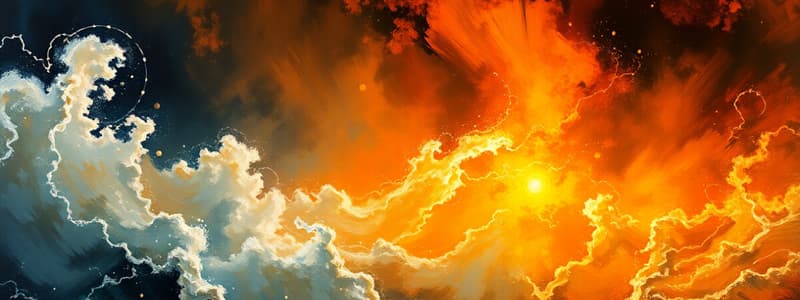Podcast
Questions and Answers
Which of the following scenarios best illustrates Newton's third law of motion?
Which of the following scenarios best illustrates Newton's third law of motion?
- A ball rolling down a hill gains speed.
- A car accelerates forward due to the engine's force.
- When you jump, your body accelerates upwards as Earth applies force, and Earth also accelerates downwards because your body is applying force to it. (correct)
- A book remains at rest on a table.
Electromagnetism exclusively deals with interactions between static electric charges.
Electromagnetism exclusively deals with interactions between static electric charges.
False (B)
Provide a concise definition of 'torque' and explain its role in rotational motion.
Provide a concise definition of 'torque' and explain its role in rotational motion.
Torque is a twisting force that causes rotation about an axis. It plays a similar role in rotational motion as force does in linear motion, affecting the angular acceleration of an object.
The Zeroth Law of Thermodynamics allows us to define and measure ______.
The Zeroth Law of Thermodynamics allows us to define and measure ______.
Match the following concepts with their area of physics:
Match the following concepts with their area of physics:
According to classical mechanics, which quantity remains constant in an isolated system?
According to classical mechanics, which quantity remains constant in an isolated system?
Work is defined solely by the magnitude of the force applied to an object, irrespective of the distance over which it acts.
Work is defined solely by the magnitude of the force applied to an object, irrespective of the distance over which it acts.
Which of the following is the best example of potential energy?
Which of the following is the best example of potential energy?
According to the first law of thermodynamics, what does $ΔU = Q - W$ represent?
According to the first law of thermodynamics, what does $ΔU = Q - W$ represent?
The second law of thermodynamics implies that in an isolated system, entropy can only decrease or remain constant.
The second law of thermodynamics implies that in an isolated system, entropy can only decrease or remain constant.
What phenomenon explains why a metal spoon gets hot when left in a hot cup of coffee?
What phenomenon explains why a metal spoon gets hot when left in a hot cup of coffee?
__________ is the ability of a system to store electric charge.
__________ is the ability of a system to store electric charge.
Match the following terms with their descriptions:
Match the following terms with their descriptions:
Ohm's Law relates voltage, current, and resistance. Which of the following equations represents Ohm's Law?
Ohm's Law relates voltage, current, and resistance. Which of the following equations represents Ohm's Law?
According to special relativity, the speed of light is different for every observer.
According to special relativity, the speed of light is different for every observer.
What term describes the phenomenon where two or more particles become linked, and the state of one instantly affects the state of the other, regardless of distance?
What term describes the phenomenon where two or more particles become linked, and the state of one instantly affects the state of the other, regardless of distance?
The equation $E=mc^2$ describes the principle of __________.
The equation $E=mc^2$ describes the principle of __________.
Which of the following is a consequence of general relativity?
Which of the following is a consequence of general relativity?
Flashcards
What is Physics?
What is Physics?
Study of matter, energy, motion, and forces in the universe.
What is Kinematics?
What is Kinematics?
Describes motion of objects without considering the causes.
What is Dynamics?
What is Dynamics?
Deals with the causes of motion, like forces.
Newton's First Law
Newton's First Law
Signup and view all the flashcards
Newton's Second Law
Newton's Second Law
Signup and view all the flashcards
Newton's Third Law
Newton's Third Law
Signup and view all the flashcards
What is Energy?
What is Energy?
Signup and view all the flashcards
What is Temperature?
What is Temperature?
Signup and view all the flashcards
First Law of Thermodynamics
First Law of Thermodynamics
Signup and view all the flashcards
Second Law of Thermodynamics
Second Law of Thermodynamics
Signup and view all the flashcards
Entropy
Entropy
Signup and view all the flashcards
Third Law of Thermodynamics
Third Law of Thermodynamics
Signup and view all the flashcards
Coulomb's Law
Coulomb's Law
Signup and view all the flashcards
Resistance
Resistance
Signup and view all the flashcards
Ohm's Law
Ohm's Law
Signup and view all the flashcards
Refraction
Refraction
Signup and view all the flashcards
Wave-Particle Duality
Wave-Particle Duality
Signup and view all the flashcards
Mass-Energy Equivalence
Mass-Energy Equivalence
Signup and view all the flashcards
Study Notes
No new information was provided, therefore the study notes remain unchanged.
Studying That Suits You
Use AI to generate personalized quizzes and flashcards to suit your learning preferences.




